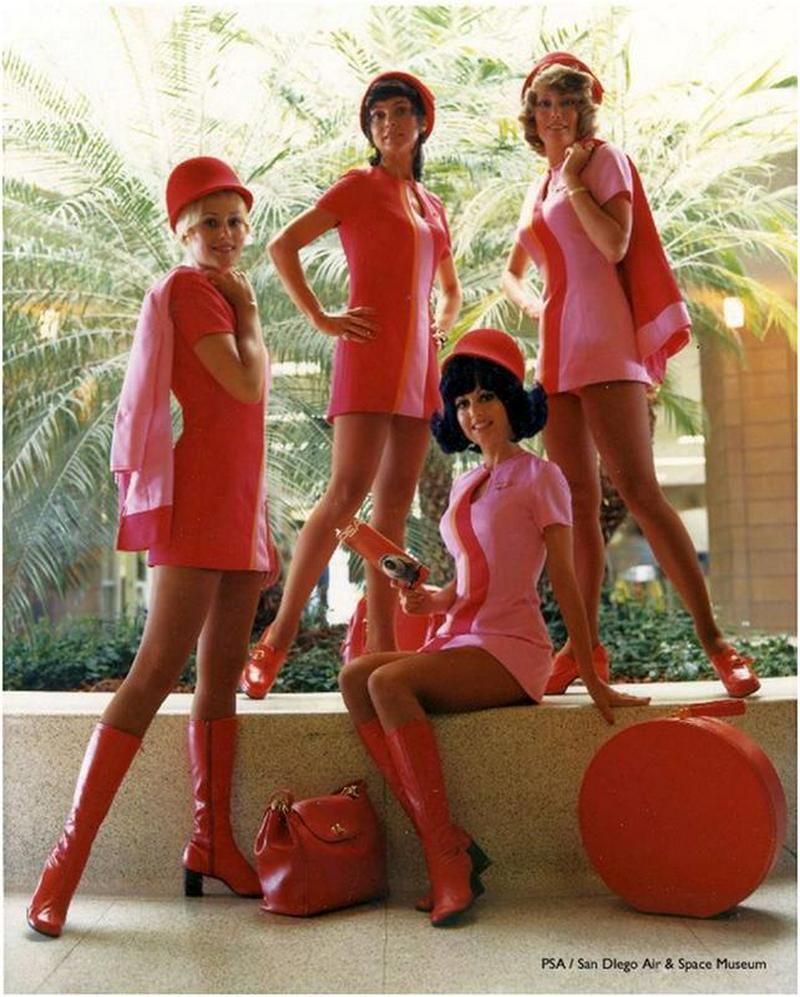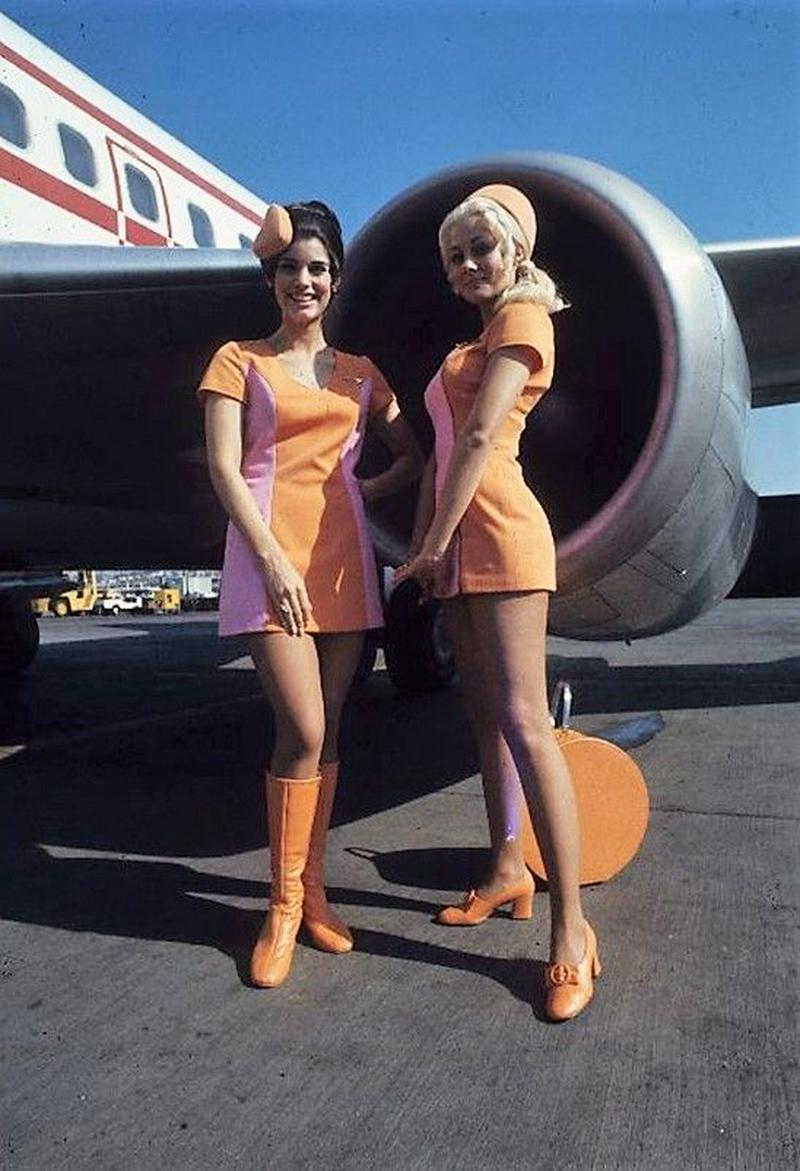Sexy Stewardesses Of The '60s and '70s: Friendly Skies Indeed
By | June 12, 2018

Today they're flight attendants, but a bygone era the servers in the sky -- who were all female -- were called "stewardesses." The golden age of the glamorous and enticing stewardess occurred in the '60s and '70s, as air travel was booming -- particularly business travel. And though social change was taking place on the streets, business was still thought to be a man's world. Stewardesses in futuristic, mod or even risque attire were a marketing ploy, as the price of airline tickets was not set by the individual airline, but by the government. If the ticket was the same price for any airline, how was a brand to gain a competitive advantage?
Stewardesses.
1960s Stewardesses Had To Meet Strict Standards

Being a stewardess in the 1960s may have seemed glamorous and exciting but stewardesses had to adhere to a strict set of rules and meet ridiculously sexist standards. Stewardesses had to be young, attractive women, between the ages of 18 and 30. Most airlines grounded stewardesses once they reached their 30s, no matter how great they were at their job. Additionally, the woman must have never been married nor had children. Typical employment ads for stewardesses stated that they should be thin and petite, weighing between 100 and 128 pounds and standing between 5’2” and 5’6”. Airlines competed for the most attractive stewardesses, turning job interviews into something more akin to beauty pageants. In fact, less than 3% of applicants were hired to be airline stewardesses…that’s a lower acceptance rate than Yale University.
Stewardess Uniforms Were The Height of Fashion

The uniform of the stewardess changed drastically during the 1960s and 1970s. At the start of the 1960s, the stewardesses wore longer skirts with jackets adorned with brass buttons, insignia, and epaulets, all intended to give them an air of confidence and experience. But as street fashions became sexier and sexier during the sixties and seventies, so did the stewardess uniform. Skirts got shorter. Jackets were replaced with fitted dresses. In the early 1970s, a few airlines even required their stewardesses to wear hot pants and go-go boots.
Top fashion designers were recruited to design stewardess uniforms, including Emilio Pucci who designed a space-age look for Braniff stewardess that mixed apricot colors with out-of-this-world helmets. Designers Jean Louis created a mod A-line dress for the stewardesses of United Airlines and accessorized it with an oversized kefi hat. Stewardess style was hot among non-stewardesses, as well.
Stewardesses Were A Symbol Of Sixties Sexism

In the sixties and seventies, the general public may have thought that being an airline stewardess was an exciting job, but in reality, stewardesses worked long hours for little pay and were subjected to sexism and discrimination. Most stewardesses only stayed the job for, on average, a year and a half. Because stewardesses were not allowed to continue flying after they turned 30, there was no longevity in the field…and no retirement package. In fact, the only benefit to being a stewardess was the opportunity to travel. While the airlines made this out to be an exciting opportunity to see the world, in reality, most of the time, the stewardesses never set foot outside the airports they traveled to. It was all about appearances for airline stewardesses, so if a woman gained weight, styled her hair in a unique way, or in any way became less attractive, she was fired…on the grounds that she was not as pretty as she should be.
1970s Stewardesses Broke Barriers

In 1968, the U.S. government finally agreed that some of the restrictions the airlines put on stewardesses amounted to discrimination. The age cap and the marriage rules were abolished, opening the doors for more women to apply to be stewardesses. During the seventies, more and more African-American women were hired by the airlines that had previously passed over their applications based on skin color. And the 1970s saw the re-introduction of male stewards. In fact, the complaints of the female stewardesses about the discriminatory rules did nothing to change them. It was the men who sought to become stewards that forced the airlines to rethink its regulations. The male airline executives turned a deaf ear to female stewardesses but listened to male ones.
Sexy Stewardesses Attracted Businessmen To Their Airline

As airlines competed for the mostly male business travelers, they marketed their sexy stewardesses. Advertisement and commercials of the time are full of sexual innuendos aimed at the travelling businessman. They include taglines such as, “Does your wife know you’re flying with us?”, “How do you like your stewardess?”, “I’m going to fly you like you’ve never been flown before”, and “I’m Cheryl. Fly Me.” All of these advertising campaigns were designed to play into the sexy stewardess/mile-high fantasy that was prevalent among travelling businessmen. Stewardesses were forced to put up with sexual advances and groping while on the job, as they were wearing sexually provocative uniforms, such as short-shorts.
It wasn’t until the deregulation of the airline industry in 1978 that working conditions began to change for stewardesses. With airlines free to set their own ticket prices, the different airlines could compete with each other on cost, not on the hotness of their stewardesses. So the term “stewardess” even fell out of fashion in favor of the more gender-neutral “flight attendant.” Stewardesses rallied for better pay and working conditions…and less provocative uniforms. In fact, the 1978 deregulation of the airline industry meant the end of the sexy stewardess era.
